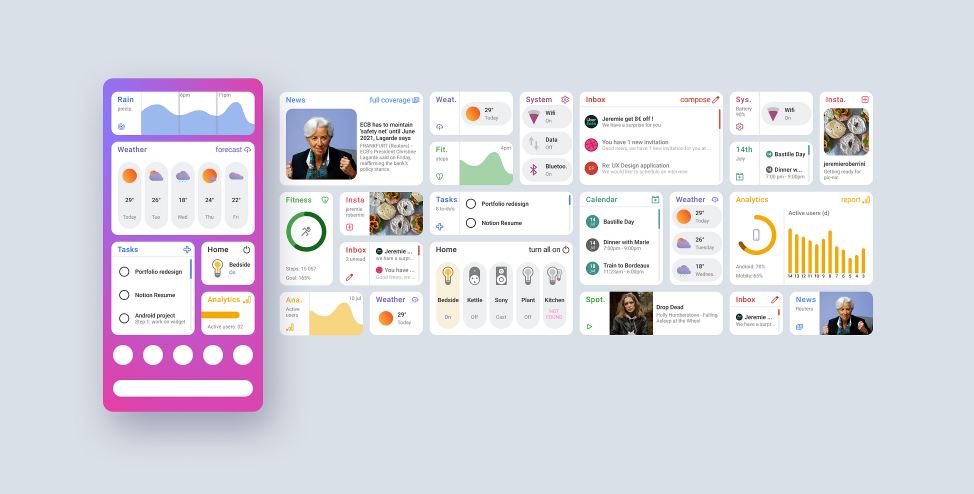Exploring the Best Android Widgets for Your Home Screen
25th August 2024
Jeff Patton
When aiming to enhance the appearance and utility of your Android home screen, widgets offer an excellent solution.
Discover superior Android widgets, encompassing clock and weather widgets, calendar widgets, music player widgets, news and RSS feed widgets, note-taking widgets, as well as fitness and health widgets.
Acquire insights on the customization and structuring of widgets, along with recommendations for optimizing their functionality.
Embark on this journey and transform your home screen into a personalized and efficient tool!
What Are the Best Android Widgets for Your Home Screen?
When considering the most optimal Android widgets for enhancing the home screen, individuals encounter a myriad of applications that provide customization attributes and interactive components. These widgets not only contribute to the functionality of the home screen but also impart a personalized essence to the device.
Noteworthy selections include weather widgets that furnish real-time forecasts, calendar widgets that facilitate organization, and clock widgets that offer diverse styles catering to individual preferences.
Moreover, music player widgets afford users the ability to manage their preferred songs directly from the home screen, whereas news widgets ensure individuals are kept informed about current headlines.
By incorporating these popular widgets, users have the opportunity to convert their home screen into a dynamic and informative platform that aligns with their particular inclinations.
1. Clock and Weather Widgets
Android users have the option to personalize their home screens by incorporating clock and weather widgets that deliver real-time updates and offer a convenient overview of crucial information. These widgets are designed for seamless integration with the device's operating system, providing users with easy access to weather forecasts and time details at a single glance.
Through user-friendly interfaces, individuals can tailor the appearance of these widgets to align with their preferences, whether by selecting various themes, colors, or display layouts.
The interactive nature of these widgets allows users to engage with them directly, such as by tapping on the clock widget to access alarms or configure location-based weather updates. The capacity to modify these widgets in accordance with individual requirements enhances the overall user experience, rendering them a valuable inclusion for any Android device.
2. Calendar Widgets
Android calendar widgets provide a seamless method for enhancing organization and productivity, offering customizable designs and interactive features that optimize schedule management. These widgets enable users to tailor their calendar view according to their preferences, whether they lean towards a minimalist aesthetic or vibrant themes.
By integrating interactive elements such as event reminders and to-do list synchronization, individuals can effectively coordinate their tasks and appointments. The capacity to customize widget sizes and layouts further enriches the user experience, facilitating quick access to upcoming schedules without the necessity of launching the full calendar application. This degree of personalization fosters a more efficient and productive utilization of time.
3. Music Player Widgets
Enhance the functionality of your Android device by utilizing interactive music player widgets that serve as a centralized music hub, granting convenient access to your preferred songs and control features directly from your device's home screen.
The utilization of these music widgets offers a seamless method to navigate through your music library, enabling you to effortlessly execute actions such as playing, pausing, skipping tracks, and adjusting volume with a simple tap or swipe gesture. The user-centric interfaces embedded within these widgets facilitate the streamlined discovery and selection of songs, ultimately enriching your overall auditory experience. Furthermore, the inclusion of intuitive design elements, such as prominent album artwork displays and customizable themes, not only enhances the functionality of your music player but also contributes to its aesthetic appeal, ensuring a harmonious blend of form and function within the music widget interface.
4. News and RSS Feed Widgets
Remain informed and maintain up-to-date awareness by utilizing news and RSS feed widgets located on your Android home screen. These widgets serve to deliver real-time updates and personalized content directly to your fingertips.
Plus offering a convenient method of staying connected, these widgets contribute to a seamless user experience by presenting a curated selection of news articles that are tailored to your individual interests. By incorporating these widgets onto your home screen, you gain the ability to easily peruse headlines, select a story of interest, and delve into the full article without the necessity of opening multiple applications.
This time-efficient feature serves to enhance your overall productivity by ensuring you remain informed without disrupting your workflow. Through the customization of settings, you have the capacity to prioritize specific topics and sources, guaranteeing that you receive the most pertinent information tailored to your preferences.
5. Note-Taking Widgets
Enhance productivity and organizational efficiency by leveraging note-taking widgets available on your Android device. These widgets provide convenient solutions for managing tasks and recording essential information while on the move.
These widgets serve as valuable tools that not only facilitate task management but also offer a range of accessibility options for users. Whether the need is to compile a to-do list, set reminders, or organize thoughts, note-taking widgets simplify the process. Incorporating features such as voice-to-text functionality and seamless integration with other applications, these widgets streamline the note-taking process, enabling users to maintain productivity while mobile.
Moreover, the ability to customize widget dimensions and layouts further enriches the user experience, ensuring swift access to notes with a simple tap on the device.
6. Fitness and Health Widgets
Monitor your fitness goals and health metrics with the aid of interactive fitness and health widgets conveniently placed on your Android home screen. These widgets offer personalized tools to support a healthier lifestyle.
Designed to seamlessly integrate into the daily routines of Android users, these widgets aim to assist individuals in maintaining a proactive approach towards their health and fitness journey. With tailored features including customizable workout plans and nutrition tracking capabilities, users can easily adjust their actions to align with their specific objectives. By utilizing interactive tools such as step counters, heart rate monitors, and calorie trackers, individuals can access real-time data to make well-informed decisions regarding their well-being.
The inclusion of these metrics enables users to effectively monitor progress, establish milestones, and refine their routines for optimal outcomes.
How Do You Customize and Organize Your Widgets?
The customization and organization of widgets on Android devices offer users the opportunity to design a home screen layout that is both personalized and efficient, catering to individual preferences.
A useful technique for customizing widgets involves resizing them to suit specific requirements. This can be achieved by initiating a long-press on the widget and adjusting its dimensions by dragging the edges accordingly. Additionally, users can rearrange widgets by holding and relocating them to different positions on the screen. To maintain a clutter-free interface, users may opt to employ widget folders to categorize similar widgets together, facilitating easier access. Exploring widget applications available on the Play Store presents users with an extensive array of options for customizing widgets beyond the standard selections that are pre-installed.
1. Resize and Reorder Widgets
Effortlessly customize your home screen by resizing and reordering widgets to establish a visually appealing and functional layout that aligns with your preferences. When optimizing your home screen, it is essential to deliberate on the widgets you choose.
Opt for widgets that not only serve a utilitarian purpose but also elevate the overall aesthetic quality of your screen. By thoughtfully selecting widgets that harmonize with each other, you can achieve a coherent and sophisticated appearance. Bear in mind that the essential element is to strike a balance between functionality and design.
Experiment with various widget sizes and placements to discover the optimal arrangement that maximizes both usability and visual appeal. Devote ample time to refining the layout until it reflects your individual style and seamlessly caters to your daily requirements.
2. Use Widget Folders
Efficiently organize widgets by leveraging widget folders to categorize and access preferred widgets conveniently from the widgets market.
Widget folders offer a practical solution for decluttering the Android home screen, enhancing a streamlined and customized user experience. By grouping related widgets into folders, users can minimize visual distractions and promptly find specific widgets as required.
Exploring the widgets market presents a plethora of widget options to cater to individual preferences and customization requirements. This versatility enables users to tailor their home screen layout to showcase their distinctive style and improve overall functionality.
3. Utilize Widget Apps
Elevate the level of customization on your home screen by diving into widget applications that provide a diverse array of features, design choices, and interactive components to tailor your experience.
These widget applications not only enable users to enhance the functionality and visual appeal of their Android devices but also provide avenues for showcasing creativity and individuality. With the premier selections available in the widget application market, users have the option to choose from an extensive range of customization features, encompassing various sizes, shapes, colors, and themes to imbue their home screens with a distinct character.
By opting for sophisticated widget applications, individuals can seamlessly integrate elements such as calendars, weather forecasts, task lists, and more into their daily digital routines, streamlining their activities with structured and aesthetically pleasing interfaces.
What Are Some Tips for Using Widgets Effectively?
To enhance the performance, battery efficiency, and user satisfaction of widgets on Android devices, it is essential to adhere to certain effective strategies.
To prevent overcrowding of the home screen, it is recommended to organize widgets that are related in functionality and purpose on specific screens. This arrangement facilitates easy accessibility for users while maintaining an aesthetically pleasing overall layout.
When choosing widgets to display, it is advisable to prioritize those that offer immediate value and information, such as real-time weather updates, upcoming calendar events, or convenient quick settings toggles. Regular updates of both widgets and their corresponding applications not only lead to performance enhancements but also contribute to improved battery efficiency. This is achieved through bug fixes and optimization of resource utilization within the widgets.
Adhering to these practices enables Android users to maximize the utility of their widgets, resulting in a more streamlined and efficient user experience.
1. Avoid Overcrowding Your Home Screen
Enhance the optimization of your home screen layout by refraining from overcrowding it with an excess of widgets, thereby ensuring a streamlined and efficient display that contributes to performance optimization.
A cluttered home screen can not only compromise the aesthetic appeal of your device but also detrimentally affect its functionality. By decluttering your home screen, you allow your device to distribute resources more effectively, resulting in enhanced system performance. An organized layout not only enhances visual appeal but also facilitates quick access to your frequently used apps and information. It is advisable to strategically organize your widgets, giving precedence to essential ones over superfluous ones to create a coherent and user-friendly interface.
2. Choose Widgets That You Will Actually Use
Choose widgets according to your preferences and requirements to ensure the integration of the most beneficial tools that enhance your Android experience with practical functionality.
When selecting widgets, contemplate the daily tasks carried out on your device, and opt for widgets that can simplify these activities. For example, if you frequently check the weather, a weather widget prominently displayed on your home screen can significantly enhance your user experience. Similarly, for individuals who are avid users of social media platforms, prioritize widgets that provide quick access to these platforms. By customizing your widgets to correspond with your routine, you can optimize your home screen for increased efficiency and convenience.
3. Regularly Update and Refresh Your Widgets
To uphold the effectiveness of your widgets, it is imperative to regularly update and refresh them to align with the latest features and performance enhancements provided by the Android operating system.
These updates introduce not only new functionalities but also enhance the overall performance of your widgets, rendering them more responsive and dependable. By keeping abreast of these updates, users can capitalize on enhancements in stability, security, and compatibility with other applications.
Scheduled widget refreshes can mitigate any disruptions or compatibility concerns that could arise from utilizing outdated versions. Embracing these updates guarantees that your widgets remain at the forefront of technological advancements, delivering a seamless and improved user experience.















